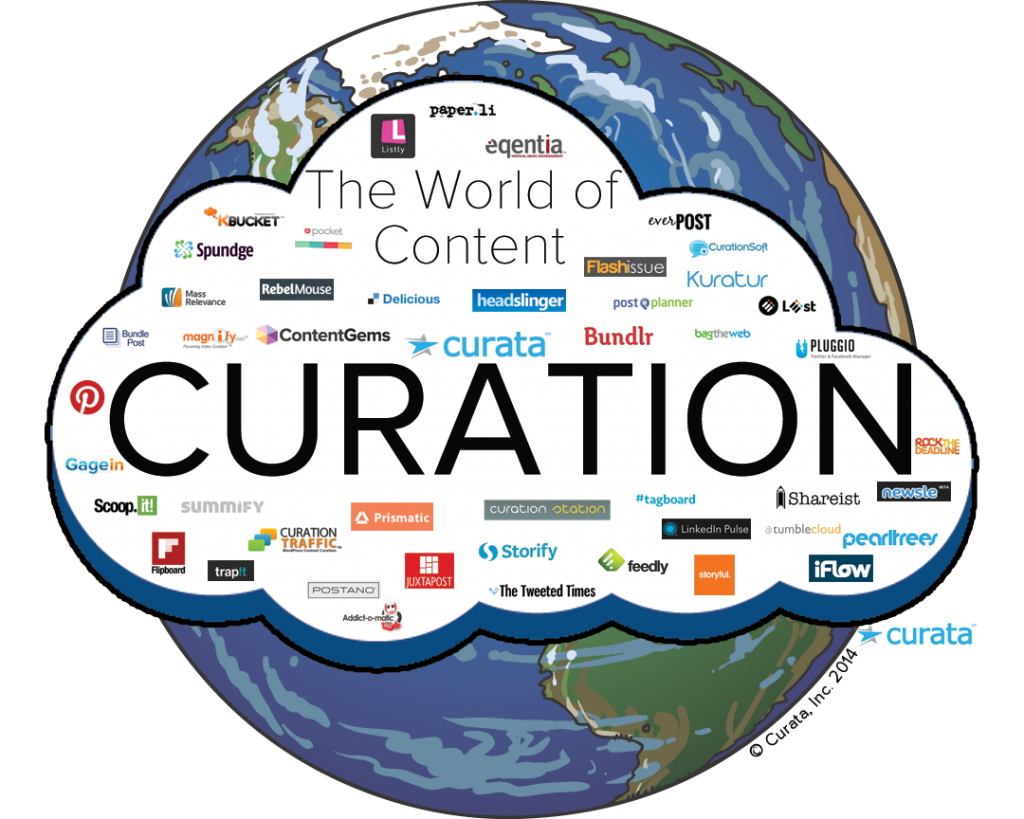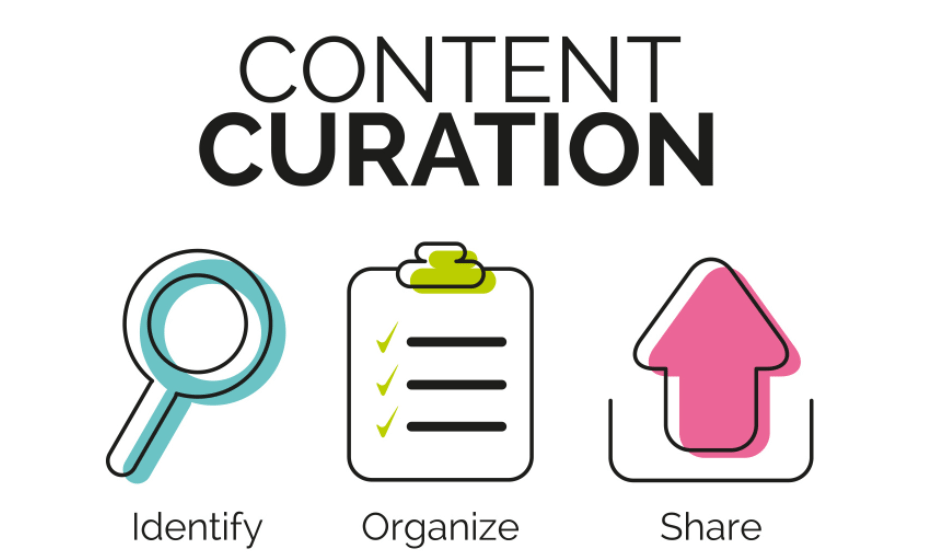Table of Contents
Content Curation: What is it?
Content curation is the practice of selecting, editing, and sharing the most relevant content on the web for a given query or topic. This improves the visibility of quality content. For curators, it allows content to be delivered to a site with minimal expense. What does content curation really cover? What are its challenges? Overview.
Content curation: monitoring and information gathering
Content curation consists of monitoring a specific theme and selecting the most relevant content. In this approach, the choice of sources and the collection of information is decisive. Afterward, these are sorted and organized before making them available to a target audience.
In other words, content curation is a human, not robotic, way of monitoring information on one or more given topic(s). This monitoring allows information to be mixed more broadly and significantly improves the relevance of shared content.
There is, however, a distinction between curation and monitoring strictly speaking.
Curation is subjective and motivated by personal reasons. Whether it is done correctly or not, it will have no real consequences. The choice of information collected, keywords, and other ancillary elements are subjective and the action is not of paramount importance. The results of curation are then released to the public.
As for monitoring, it constitutes a real business strategy, aimed at improving its performance. She is rigorous and alert, playing the role of a radar. Its success is very important, even essential to the company. Regarding the results, these are distributed to a few people, mainly: to the sponsors.
Content curation: information sorted by theme
The very principle of curation is to sort information by theme. It is first and foremost an information processing activity on the web. It responds to the challenges of digital culture on specific subjects.
Thus, identifying the theme is a crucial step. First, the curator must choose a theme that falls within his area of expertise. In this way, he is able to comment on the relevance of the information and the quality of the content. Otherwise, it makes a misinterpretation or is not very productive. The point is to know how to distinguish the most relevant information on the web from that which does not add value. The curation of content goes in the direction of a better knowledge of digital data.
After the expertise of the curator, it is necessary to consider the interest of the public and particularly that of a given target. Thus, it can be a clientele or a set of prospects with common interests. It is around this common interest that the theme or subject is established. Despite the precision of the analysis to be carried out, it must be large enough to ensure the broadening of the fields of collection.
The benefits of content curation

Content curation makes it possible to select pages for their relevance and the quality of their content. We can then classify them by theme, for more practicality, and then share them. The advantages of this activity are numerous, both for the curator himself and for Internet users.
The benefits of content curation for the curator
Content curation can perfectly be part of a digital web marketing strategy for the curator. He collects and shares quality information on a theme that he knows perfectly. Then, he shares this same content with his target audience. Filtering is no longer done by a robot but by a human. However, this inevitably pleases and allows to capture the attention of the greatest number. Contextualization work allows it to provide its targets with more concise texts.
Another advantage for the curator is to sharpen his critical spirit while implementing a communication strategy. For many students and young specialists, this is an excellent way to develop their skills on a given topic. Knowing how to distinguish between real information and less relevant content, learning more about the area concerned…this is what content curation also offers for those who are in charge of this activity. Curation is therefore an integral part of any learning process, both for the curator and for the Internet users.
The benefits of content curation for Internet users
It is undoubtedly for Internet users that the advantages of content curation are most visible. First of all, this activity presents a real saving of time in the appreciation of content on the web. Faced with the overabundance of information, it is sometimes difficult to navigate and know what information to take into account. The Internet users concerned therefore no longer need to scan the news to find out about their respective fields. In case information deserves further reading, the source is available.
For the sources, they have backlinks that can improve traffic to their page. The backlinks can be of quality, because a curation page in principle only contains a limited number of sources, and therefore links. These increase in value as the curated page gains notoriety.
Finally, content curation avoids the Filter Bubble, a term designating the shortcomings of algorithms and search engines that focus only on the topics most appreciated by the user, to the detriment of other content that is sometimes more relevant.
This way of acting traps a large number of Internet users in a fairly restrictive vision of the world and many enriching contents fall by the wayside. The fact for a human to carry out an expert digital watch allows many people to benefit from this content which would have been deleted by the algorithms.
Content Curation: Importance of Sources and Relevance of Information

source identification
Once the subject and theme have been established, it is necessary to proceed to the identification of the sources. These are very important and should be mentioned in the web content. Thus, the relevance of the material above all credibility of the sources is guaranteed. Again, they must be multiple to have enough point of view that allows the target to go around the question quickly.
Thanks to the extended themes, we have maximum resources that allow us to provide quality content. In fact, by considering a core theme and related topics, we manage to collect content that is as relevant as it is diverse. Once collected, sorted, and structured, the content can be shared directly.
To keep intellectual honesty at a minimum, you should never forget to cite sources. Furthermore, an audience composed of connoisseurs wants to know the source of each material before deciding on the relevance of the analysis or approach. Also, some of them like to delve deeper into the matter. In this case, we give them a real head start.
Relevance of selected content
Above all, the content should be relevant. This is the basis of any content curation strategy. Given the information infobesity and the fierce competition that prevails in the field of the web, relevant content makes it possible to find a niche with a target. To keep competitors away, don’t hesitate to improvise content. Of course, the duration of the material does not require such an approach, but the brevity of the text and the concentration of information is necessary.
In theory, the duration of the content makes it possible to exploit all the possibilities of the web. This is why sources must consider all media. In fact, they can come from specialized blogs as well as news sites, RSS feeds, articles from online newspapers and various platforms, etc. Thus, editors of original content can include experts, journalists, promoters, opponents, and other professionals.
Sharing relevant information
After demarcating the theme, and adding values to sources and content, it’s time to share them. It is important to consider the behavior of its targets to ensure the effectiveness of this measure.
Under these conditions, it is necessary to determine the channels that make it possible to reach the target. Do not hesitate to use one or two channels in particular. On the other hand, we can bet on a multi-channel strategy by creating a link between them. You can send compelling summaries to relevant professionals on a social network or with a link pointing to a web page.
To share relevant information, there are many particularly suitable tools. It allows you to store, organize and share content found on the web. Content can be very diverse: photos, web pages, articles, notes, files, or even videos.





